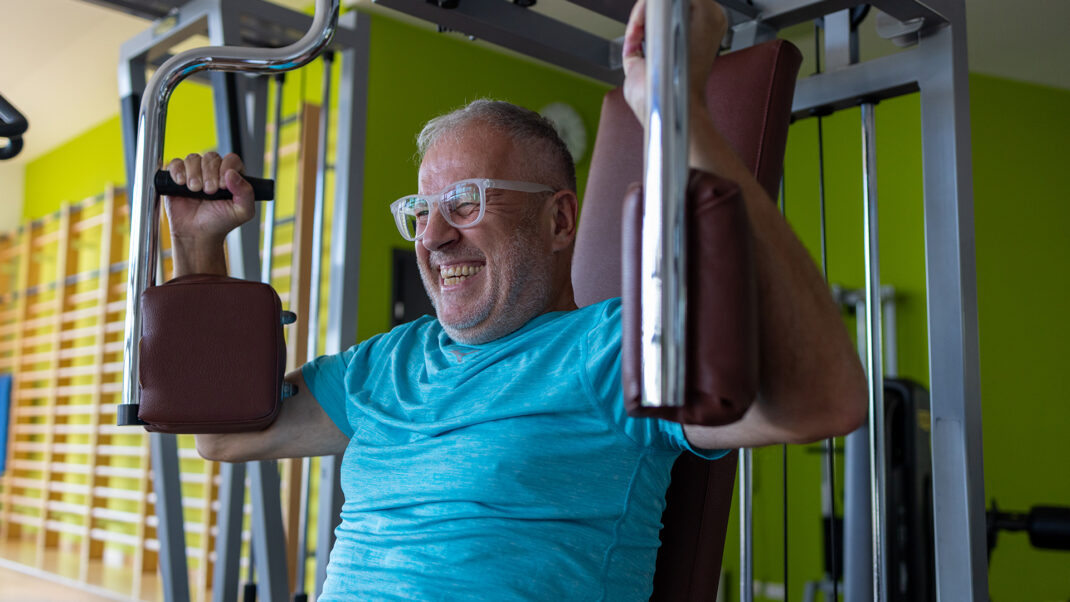Resistance Training for Older Adults: New NSCA Position Stand
Evidence-based program design for strong results.

STUDY REVIEWED: Fragala, M.S., et al. 2019. Resistance training for older adults: Position statement from the National Strength and Conditioning Association. The Journal of Strength and Conditioning Research, 33 (8), 2019–52.
Fitness professionals know that resistance exercises are pivotal for maintaining and increasing muscle strength and mass as well as thwarting the negative effects of a sedentary lifestyle, particularly as we age. The National Strength and Conditioning Association recently addressed these issues in the organization’s first position stand on resistance training for older adults (ages 65 and older). Replete with 663 research citations, the paper focuses on how muscle mass and strength interventions can minimize the deleterious effects of immobility, manage chronic disease, and improve physical functioning, psychological well-being and quality of life. Highlights from this new statement bring to light compelling evidence that resistance training should be a lifelong activity for all.
Resistance Training Guidelines for Older Adults
Resistance training is beneficial and safe for healthy older adults with proper instruction and spotting to ensure correct exercise technique. Fragala et al. suggest that program design should follow an individualized, periodized progression while observing these overarching guidelines:
- Incorporate resistance training 2–3 times a week.
- Strive to complete 2–3 sets per major muscle group with 2 minutes of rest between sets.
- Include 8–10 exercises, such as shoulder press, chest press, latissimus dorsi pulldown, biceps curl, triceps extension, lower-back extension, abdominal crunch, leg press (or quadriceps extension), leg curl and heel raise.
- For people beginning a resistance training program, the research indicates no difference in physiological outcome between single sets and multiple sets, so starting entry-level older clients with single-set training is appropriate. Load intensity should progress from low (<51% of one-repetition maximum) to moderate (51%–69% of 1-RM) and eventually, for some older clients, to high (70%–85% of 1-RM).
Fragala and colleagues state that training to failure has not been shown to promote any additional physiological adaptation in older people. In fact, for many older clients, training at 50%–70% of 1-RM with excellent exercise form may be a more than satisfactory (and safe) muscular training stimulus. This underscores the importance of individualizing the training program. The researchers note that 10–15 repetitions is suitable for beginners and 6–12 repetitions, with variation, is suitable for muscular strength development in healthy older clients.
Incorporating power exercises—performed at 40%–60% of 1-RM—is also encouraged in resistance training program design for seniors. This type of training involves performing concentric actions explosively up to maximal exertion. Fragala et al. highlight that this power component has been found to promote greater functional improvement in activities of daily living.
See also: High-Intensity Functional Resistance Training for Older Adults
Research Highlights: Noteworthy points from the NSCA Position Statement about Resistance Training for Older Adults

Strength, power, endurance and resistance training for older adults can counteract declines in physical fitness and neuromuscular function.
- Studies show that up to 76% of muscle mass and 65% of muscle strength are attributable to heredity.
- Developing a combination of strength, power and endurance is the best strategy for counteracting declines in muscular strength, mass, cardiorespiratory fitness, neuromuscular function and functional capacity in older people. Each client’s program should strike an optimal balance among training variables (volume, intensity, frequency, exercise selection, exercise order) and workout duration for both aerobic and resistance training.
- Functional training improves activities of daily living. Ideally, fit pros should choose functional moves that follow movement patterns similar to a client’s daily activities.
- With frail older adults, beginning exercisers and those with functional limitations, using machine-based resistance equipment is an appropriate starting point. High-functioning older adults gain greater benefits using free weights.
- In the United States, 30% of older adults experience at least one fall annually; that percentage goes up to 50% for those over age 80. Older adults without a fall history report doing more aerobics and resistance training sessions than those who have experienced falls.
- Mental health disorders—such as dementia, depression and Alzheimer’s disease—affect 20% of older men and women.
See also: Boosting the Brain Health of Older Adults
Frailty Guidelines for Seniors
Fragala et al. define frailty as “an age-associated disorder characterized by decreases in the biological functional reserve and resistance to stressors due to changes in several physiological systems.” In short, frailty is the main risk factor for disability in aging men and women.
Resistance training may help restore physical function in this population. The new position stand provides these recommendations:
- Do 2–3 sessions per week, working up to 3 sets of 8–12 repetitions per session.
- Start load at 20%–30% of 1-RM, potentially increasing over time to 80% of 1-RM.
- Incorporate power exercises performed at 30%–60% of 1-RM.
Functional exercises that simulate activities of daily living (e.g., sit-to-stand) also enhance functional capacity.
See also: Functional Training for Active Aging
The Deleterious Effects of Losing Muscle Strength and Mass
Fragala et al. state that a gradual loss of muscle mass (in sedentary persons) generally begins after age 30. The authors add that 10% of sedentary adults over age 60 show meaningful muscle loss and 50% of inactive adults over age 80 show a notable loss of muscle.
Loss of muscle mass and the loss of muscular strength that accompanies it are both highly associated with physical disability, type 2 diabetes, cognitive decline, osteoporosis and mortality.
Alarmingly, the researchers cite evidence that people who are inactive have double the risk of future mobility limitations compared with those who meet the U.S. Surgeon General’s recommendation for physical activity (at least 150 minutes of moderate-intensity physical activity per week).
Counteracting the Negative Consequences of Aging

Resistance training for older adults can slow down age-related health conditions and help to reduce falls and fractures.
The health benefits of resistance training for older adults are truly impressive. Fragala et al. summarize research showing that resistance training can slow down age-related accumulation of intramuscular and abdominal fat, improve muscle quality, increase bone density, improve metabolic health and insulin sensitivity, enhance amino acid uptake and protein synthesis, and help to reduce falls and fractures in older adults. In addition, resistance training is effective in lessening age-related decreases in functional capacity and neuromuscular function.
Distressingly, despite these splendid health benefits of resistance exercise, Fragala and colleagues cite data showing that only 8.7% of persons 75 years and older in the U.S. participate in muscle-strengthening activities.
See also: Training for Balance and Function Reduces Falls Among Older Adults
Safety Concerns for Resistance Training Older Adults
The position stand states that most resistance training injuries in older people occur among inexperienced exercisers. These injuries appear related to repeated performance of heavy-loaded exercises, poor exercise technique and inappropriate exercise selection.
Fragala et al. provide the following safety guidelines on designing resistance training programs for older clients:
- Take special care when training the shoulder complex, as this joint may be susceptible to injury. The knees, hips and spine are other joint areas where particular care is needed.
- If a client has uncontrolled hypertension, avoid acute elevation of blood pressure, heart rate and cardiac output. Resistance training is generally safe for people with controlled high blood pressure.
- Be aware of any cardiovascular risk factors your clients may have so you can determine the safest and healthiest path forward for their resistance training.
- Make sure older clients with unstable medical conditions consult with their physicians before starting a resistance exercise program.
- Be careful when selecting exercises for power development, to reduce the risk of injury.
- To minimize pain or discomfort in clients with osteoarthritis, pay special attention to exercise selection, intensity and volume. Consider range-of-motion limitations when identifying the most appropriate exercise approach.
Note: People with multiple comorbidities (two or more chronic diseases or conditions at the same time) may be taking medications with potentially undesirable side effects. Resistance training is relatively free of such effects.
Let Evidence Be Your Guide
This position statement provides substantial, evidence-based recommendations that allow fitness professionals to move forward enthusiastically in designing and implementing resistance training for older adults in their programming. Keep lifting!
Len Kravitz, PhD
Len Kravitz, PhD is a professor and program coordinator of exercise science at the University of New Mexico where he recently received the Presidential Award of Distinction and the Outstanding Teacher of the Year award. In addition to being a 2016 inductee into the National Fitness Hall of Fame, Dr. Kravitz was awarded the Fitness Educator of the Year by the American Council on Exercise. Just recently, ACSM honored him with writing the 'Paper of the Year' for the ACSM Health and Fitness Journal.






